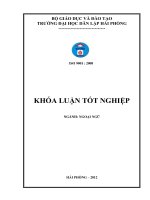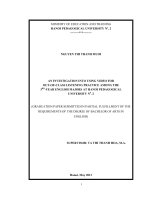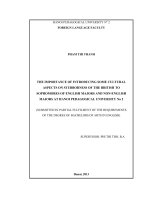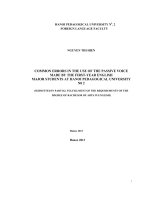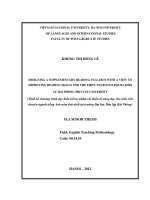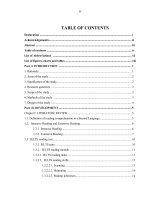An investigation into using video for out of class listening pactice among the 3rd year english majors at hanoi pedagogical university no 2
Bạn đang xem bản rút gọn của tài liệu. Xem và tải ngay bản đầy đủ của tài liệu tại đây (608.42 KB, 63 trang )
MINISTRY OF EDUCATION AND TRAINING
HANOI PEDAGOGICAL UNIVERSITY Nº. 2
=====***=====
NGUYEN THI THANH MUOI
AN INVESTIGATION INTO USING VIDEO FOR
OUT-OF-CLASS LISTENING PRACTICE AMONG THE
3RD-YEAR ENGLISH MAJORS AT HANOI PEDAGOGICAL
UNIVERSITY N0. 2
(GRADUATION PAPER SUBMITTED IN PARTIAL FULFILLMENT OF THE
REQUIREMENTS OF THE DEGREE OF BACHELOR OF ARTS IN
ENGLISH)
SUPERVISOR: TA THI THANH HOA, M.A.
Hanoi, May 2013
i
ACKNOWLEDGEMENTS
I would like to take this chance to express my greatest gratitude to my
supervisor, Ms. Ta Thi Thanh Hoa, M. A., for her patience in providing
continuous and careful guidance as well as encouragement, indispensable
suggestions and advice.
I am greatly indebted to the teachers of English at Hanoi Pedagogical
University N0.2 for their help and guidance while I was carrying out the survey.
I wish to thank all lecturers at Hanoi Pedagogical University N˚. 2, especially
the lecturers in the Foreign Language Faculty for their instruction during my years
of university work.
I would also like to take this opportunity to express my deepest thanks to 3rdyear English majors at Hanoi Pedagogical University N0.2 for their help in
completing the survey questionnaires, and for the willingness to share their
relevant problems with me.
I am particularly grateful to my close friends for their enthusiasm and
kindness in sharing me valuable documents for my research.
Last but not least, I owe a debt of gratitude to my beloved family, for their
whole- hearted encouragement and endless support.
ii
ABSTRACT
This study aims at surveying the benefits of using video in learning listening
and suggests suitable techniques of using video which may help the students and
teachers to improve the current situation.
The thesis consists of the theoretical background about listening
comprehension, the role of listening, and the benefits of using video in listening
practice. Based on the data analysis and tests’ result analysis, the success of using
video in English listening practice and the types of problems and causes have been
found. Solutions to the problems have been suggested.
iii
STATEMENT OF AUTHORSHIP
Title: An Investigation into Using Video for Out-Of-Class Listening
Practice among the 3rd-year English Majors at Hanoi Pedagogical
University N0.2
(Graduation paper submitted in partial fulfillment of the Degree of
Bachelor of Arts in English)
I certify that no part of this report has been copied or reproduced from any
other person’s work without acknowledgements and that the report is originally
written by me under strict guidance from my supervisor.
Date submitted: May 2013
Student
Supervisor
Nguyen Thi Thanh Muoi
Ta Thi Thanh Hoa, M.A.
iv
LIST OF TABLES AND CHARTS
Tables:
Table 1: The effectiveness of using video in listening practice
Table 2: Some negative attitudes towards using video in listening practice
Table 3: Students’ favorite while-listening activities
Charts:
Chart 1: Students’ difficulties in listening
Chart 2.1: Students’ frequency of practicing listening English through video
Chart 2.2: Students’ attitudes towards video listening
Chart 3: Students’ while -listening activities
Chart 4: Students’ application of effective techniques of using video for out-ofclass listening
Chart 5: Raw marks in listening pre-test
Chart 6: Raw marks in listening post-test
v
TABLE OF CONTENTS
ACKNOWLEDGEMENTS .................................................................................. i
ABSTRACT .......................................................................................................... ii
LIST OF TABLES AND CHARTS .................................................................... iii
STATEMENT OF AUTHORSHIP .................................................................... iv
TABLE OF CONTENTS ..................................................................................... v
PART ONE: INTRODUCTION
I. Rationale ........................................................................................................... 1
II. Research presupposition ................................................................................. 2
III. Research objectives........................................................................................ 2
IV. Research scope ............................................................................................... 3
V. Research tasks ................................................................................................ 3
VI. Research methods .......................................................................................... 3
VII. Significance of proposed research ............................................................... 4
VIII. Design of the research work ............................................... ……………….4
PART TWO: DEVELOPMENT
CHAPTER ONE: THEORETICAL BACKGROUND
I.1. Literature review in brief .............................................................................. 6
I.2. General concepts of listening comprehension .............................................. 7
I.2.1. Definition of listening comprehension........................................................... 7
I.2.2. Listening comprehension process .................................................................. 8
I.2.2.1. Bottom- up process .................................................................................... 8
I.2.2.2. Top- down process ..................................................................................... 9
I.2.2.3. Interactive process...................................................................................... 9
I.2.3. Stages of listening comprehension .............................................................. 10
I.2.3.1. Pre-listening ............................................................................................. 10
I.2.3.2. While-listening ......................................................................................... 10
I.2.3.3. Post-listening............................................................................................ 10
I.3. The roles of listening in foreign language teaching and learning .............. 11
I.3.1. Language acquisition .................................................................................. 11
vi
I.3.2. Speaking skill development......................................................................... 12
I.3.3. One of ultimate goals of learning a language............................................... 12
I.4. General concepts of video ............................................................................ 13
I.5. Uses of video in learning language ............................................................. 14
I.5.1. For its own sake .......................................................................................... 14
I.5.2. For comprehension of spoken language ...................................................... 14
I.5.3. As a language model ................................................................................... 14
I.5.4. Cultural values ............................................................................................ 15
I.5.5. As a stimulus for input ............................................................................... 15
I.5.6. As a moving picture book ........................................................................... 15
I.6. The effectiveness of using video in listening comprehension enhancement ... 16
I.6.1. Generating interest, motivation and concentration in listening .................... 16
I.6.2. Lowering anxiety in listening ...................................................................... 17
I.6.3. Helping learners study on-verbal and non-verbal aspects of communication .... 18
I.6.4. Providing the background of communication .............................................. 19
CHAPTER TWO
METHODOLOGY AND RESEARCH FINDINGS
II.1. Survey ......................................................................................................... 20
II.1.1. Purpose of the survey ................................................................................. 20
II.1.2. Population of the survey ............................................................................ 20
II.1.3. Type of the survey ..................................................................................... 21
II.1.4. Construction of the test .............................................................................. 21
II.1.5. Presentation of the survey .......................................................................... 21
II.1.5.1. Test items................................................................................................ 21
II.1.5.2. Arrangement of the test items ................................................................. 22
II.1.6. Administration of the try-out ..................................................................... 22
II.1.6.1. Presentation of the try-out ....................................................................... 22
II.1.6.2. Try out .................................................................................................... 22
II.1.7. Method of data analysis ............................................................................. 22
II.2. Data analysis and discussion ...................................................................... 24
vii
II.2.1.Data analysis ............................................................................................... 24
II.2.1.1. Students’ difficulties in listening practice ............................................... 24
II.2.1.2. Students’ attitudes towards the use of video in English listening practice.. 25
II.2.1.3. Students’ activities while practicing listening ......................................... 30
II.2.1.4. Students’ application of effective techniques of using video for out-ofclass listening ....................................................................................................... 31
II.2.2. Tests’ result analysis .................................................................................. 32
II.2.2.1. Analysis of the pre-test ........................................................................... 32
II.2.2.2. Analysis of the post-test .......................................................................... 34
II.2.3. Discussion of the findings .......................................................................... 35
II.2.3.1. Success in terms of applying video in listening practice.......................... 35
II.2.3.1.1. Developing confidence in listening ...................................................... 35
II.2.3.1.2. Improving pronunciation ...................................................................... 36
II.2.3.1.3. Motivating students’ interest in listening.............................................. 36
II.2.3.1.4. Increasing input comprehension ........................................................... 37
II.2.3.2. Problems ................................................................................................. 37
II.2.3.2.1. The mixed ability among the students .................................................. 37
II.2.3.2.2. The choice of unsuitable video in listening .......................................... 38
II.2.3.2.3. Inappropriate listening tasks designed from video................................ 38
CHAPTER THREE: SUGGESTED SOLLUTIONS
III.1. Selecting video materials .......................................................................... 39
III.2. Some techniques of using video ................................................................ 40
III.2.1. Sound off/vision on (silent viewing) ......................................................... 40
III.2.2. Sound on/vision off (sound only).............................................................. 40
III.2.3. Sound on and vision on (normal viewing) ................................................ 41
III.2.4. Split viewing ............................................................................................ 41
III.2.5. Jumbled sequence ..................................................................................... 41
III.3. Varying tasks designed from video .......................................................... 42
III.3.1. Diagram labeling ...................................................................................... 42
III.3.2. Matching .................................................................................................. 42
viii
III.3.3. Dictation ................................................................................................... 42
III.3.4. Gist listening ............................................................................................ 43
III.3.5. Note- taking .............................................................................................. 43
III.3.6. Predicting language .................................................................................. 43
III.3.7. Spotting activities ..................................................................................... 43
PART THREE: CONCLUSION
CONCLUSION................................................................................................... 44
REFERENCES ................................................................................................... 46
APPENDICES .................................................................................................... 48
LISTENING PRE-TEST ................................................................................... 48
LISTENING POST-TEST ................................................................................. 49
SURVEY QUESTIONAIRE .............................................................................. 51
ix
PART ONE
INTRODUCTION
I. Rationale
English language has been recognized as a means of communication in the
world. It is the official language of many developed counties and is taught as the
second foreign language in most of the countries across the world. Today,
knowledge of English language has become the basic requirement in most of the
aspects such as economy, science, education, culture and so on. Therefore,
mastering English will help people enrich their knowledge about the world.
For its great importance, English has now a mandatory subject in all schools
in Vietnam. In recent years, with the prevalence of the communicative approach,
English are taught as a tool of communication. In this communicative process,
listening comprehension plays an important role. Foreign language listening
comprehension is a complex process and crucial in the development of second
language competence, and the importance of listening in language learning has
only been recognized recently (Celce-Murcia, 2001). Because the role of listening
comprehension in language learning was either overlooked or undervalued, it
merited little research and pedagogical attention in the past. But at present, some
researchers have devoted some time to listening and believe it to be an important
skill in teaching and learning.
Videos have become more and more popular in language practicing for
decades. Language skills, namely speaking, listening, reading, and writing, can be
instructed with videos. Videos are not only used for entertainment, but they also
can provide a great approach for language teaching and learning. In addition,
videos can motivate students to engage in language learning. The availability of
videos for use in practicing listening is increasing. Most often a video film is used
to present communicative situations in context. The video is an important resource
that may be used by teachers of English. Experience also shows that activities
based on video materials encourage more communication among learners. When
they watch a video, learners are able to understand that gestures, facial expressions,
1
postures and body language are generally more important for communication than
verbal messages. Therefore, students can improve their comprehension if they pay
full attention to sounds and meaning whenever they view videos.
Unfortunately,
using
English
video
for
listening
comprehension
enhancement seems to be the most challenging to many students. This is also a big
problem that most students especially the 3rd-year students are encountering.
Moreover, as a prospective teacher, I would like to make a contribution to the
English teaching in Vietnam. In addition, the research available on secondlanguage comprehension is insufficient. Comparing with other skills, there are
fewer insights about the process of listening and the way it is learnt.
For all the things mentioned above, the researcher finds it necessary to carry
out the investigation into “using video for out-of-class listening practice among 3rdyear English majors at Hanoi Pedagogical University N0. 2”. It is hoped that the
results of this investigation will cast some light on this issue and pave the way for
better listening.
II. RESEARCH QUESTIONS
Some questions are raised:
1) What problems of using video in listening practice are most often faced by the
3rd-year English majors at Hanoi Pedagogical University N0. 2 (HPU2)?
2) What are the causes of the problems of using video in listening practice faced
by the 3rd-year English majors at HPU2?
3) What effectiveness of using video for out-of-class listening practice is achieved
by the 3rd-year English majors at HPU2?
Based on the questions above, I am eager to learn about the effectiveness and
make a problem analysis so that the effective ways in using video for listening
practice may be found.
III. RESEARCH OBJECTIVES
The purpose of this study is to investigate the effectiveness of using video
for listening comprehension enhancement among the 3rd-year English majors so
2
that some suggestions of how to use video in practicing listening skills in the
classroom can be given to help students improve these skills.
The specific aims are as follows:
1) Investigating the students’ attitudes towards listening through video.
2) Finding out the effectiveness of using video in practicing listening
comprehension.
3) Suggesting some techniques of using video in practicing listening out of class.
IV. RESEARCH SCOPE
In this study, the researcher conducted a survey on using video in listening
practice to find out how to improve students’ listening skills through video.
The survey was conducted on thirty 3rd-year English majors at HPU2.
The use of video lasted for the period of 8 weeks with the purpose of
practicing the listening skills through video. Video is used outside classroom as an
extra activity. The video materials were taken from the Oxford English VideoLifetime,
by
Tom
Hutchinson
(1999)
and
from
website
/>V. RESEARCH TASKS
The study involves fulfilling the following tasks:
1) To study the general concepts of listening comprehension.
2) To provide insight into significance of listening in language teaching and
learning.
3) To study the uses of video in learning language and the benefits of using video
in listening comprehension enhancement.
4) To conduct a survey to find out the effectiveness of using video for listening
practice and the common difficulties in using video in the classroom. On the
basis of the findings, some recommendations to the difficulties are sought to
overcome these difficulties and take full advantage of videos.
VI. RESEARCH METHODS
In order to achieve the objectives of this study, both the qualitative and
qualitative methods are used and the data for analysis in the study are collected
from different resources as follows:
3
Survey questionnaires were designed for collecting data for analysis from the
3rd-year majors at HPU2 (these students had access to videos out of class).
Interviews: the researcher also interviewed some students to double check the
information gained from the questionnaires. However, the interviews were
sometimes applied if the author finds that the answers of respondents were not
clear enough.
Tests for students (a pre-test and a post-test): the aim of the tests is to find out
what progress videos help students to make in their listening skills. The tests were
delivered to students at the first and at the eighth week of the study.
VII. SIGNIFICANCE OF THE PROPOSED RESEARCH
It is no doubt that using video in listening language practice, particular in
English listening as a foreign language, brings advantages. However, several
problems in using it in listening practice are sometimes predictable and sometimes
unpredictable. It is, therefore, essential for teachers to have better treatment to
anticipate problems. After the research, it is hoped that the results will be of great
value:
1) For learners of English, the result of this study will have positive impact on the
learning quality in listening practice through videos.
2) For teachers of English, the findings of this study will provide valuable
information on problems and suggested solutions to the problems so that they
can have effective methods of using video for listening practice.
This study is also beneficial to anyone who is interested in using video for
listening practice.
VIII. DESIGN OF THE RESEARCH WORK
The research has three main parts, namely: Introduction, Development and
Conclusion. The part “Development” consists of two chapters. Chapter one is
entitled “Theoretical background”. It includes two sections. Section one reviews
literature review in brief. The second one deals with things related to listening
comprehension such as definition, process and stages of listening comprehension
4
as well as the uses and the benefits of using video in practicing listening
comprehension.
Chapter two is named “methodology and research findings”. It has three
sections. Section one is devoted to the survey. The second deals with data analysis
of using video for out-of class listening practice. The last one is on some suggested
solutions to the problems on using video in practicing listening comprehension.
5
PART TWO: DEVELOPMENT
CHAPTER ONE: THEORETICAL BACKGROUND
I.1. Literature review in brief
Using video to learn a language has been described by many grammarians
like Pano Michaelides (2004), Stempleski and Sand Arcanorio (1990), Arthus, P.
(1999), Sherman, J. (2003), Katsiashviki (2010), Cooper, R., Lavery, M. and
Rinvolucri, M. (1991), Barry Tomalin and Stempleski, S.(2001), and so on. They
each have their own way to describe videos. Generally, they focus their attention
on history, benefits of video and ways of using video in practicing listening
language.
Arthus, P. (1999) in Why Use Video? A Teacher’ Perspective describes the
current theory on the use of video as an Education Medium of Instruction. He also
gives ways of using video in the F/SL classroom.
Moreover, he focuses on
considerations for using video in the classroom with nonnative speakers.
In the book using Authentic Video in the Language Classroom, Sherman, J.
(2003) describes the reason for using video. He also focuses his attention in uses of
video in language teaching. Furthermore, he introduces some ways of using video
and understanding video.
Pano Michaelides (2004) in the TESOL Video News mentions some of most
basic practical techniques for using video. In addition, he introduces a collection of
some specific activities focusing on language and literature, the storyline,
comprehension and viewers.
Katsiashviki (2010) in the book the Role of the Video in Language Learning
mentions the history of using video. In addition, they focus on advantages of using
video in EFL classroom. Besides, he pays his attention to the role of video in
language learning.
In the book Video in Action: Recipes for Using Video in Language Teaching,
Barry Tomalin and Stempleski, S. (2001) focuses his attention to how to use video
in language teaching.
6
Stempleski, Sand Arcanorio (1990) in the book Video in Second Language
Teaching: Use, Selecting, and Producing Video for the Classroom describe the
history of video. In addition, they concentrate on the ways of using and selecting
video. Besides, they pay much attention on how to produce video for the classroom.
In the book Video, Cooper, R., Lavery, M. and Rinvolucri, M. (1991) give
the definition and benefits of using video. They also focus on the reality in the use
of video as a TV- video image. Furthermore, they pay their attention to the
effectiveness of using video recording in learning a language. Besides, they
concentrate on some activities using video.
In summary, much research has been done on video but very little research
has been conducted to point out the effectiveness of using video for out-of-class
listening comprehension enhancement. Considering the importance of this issue, it
is essential to conduct a comprehensive investigation into using video for out-ofclass listening comprehension enhancement.
I.2. General concepts of listening comprehension
I.2.1. Definition of listening comprehension
Many researchers agreed that language is the tool of communication, while
listening is a great important part of language communication and it is the basic
path to understand others. Listening is more than merely hearing words and
comprehension is often consider to be the first goal of listening, and the highest
priority of the listener. During the last few decades, scholars have been trying to
find out the nature of listening comprehension and different definitions of listening
comprehension have been proposed.
According to Boyle (1981), “listening comprehension is defined as the
process of understanding speech in a second or foreign language. When
comprehending something, we can understand what is said. It is assumed that
speaking and writing are the process of encoding messages while listening and
reading decode them. Listening comprehension, therefore, is a perceptive skill
involving identifying and retaining information orally perceived.”
7
In Buck’ point of view, “listening comprehension is an active process of
constructing meaning and this is done by applying knowledge to the incoming
sound “in which” numbers of different types of knowledge are involved; both
linguistic knowledge and nonlinguistic knowledge.” (Buck, 2001)
More specifically, Anderson and Lynch (1988) believe that listening
comprehension requires both the linguistic knowledge and nonlinguistic
knowledge in order to reach the final message of the speaker in communication.
According to them, “listening comprehension means to understand what a speaker
says: the listener has a crucial part to play in the process by activating various
types of knowledge, by applying what he knows to what he hears and trying to
understand what the speaker means.”
In summary, listening comprehension involves multiple skills. It is a
complex and active process of interpretation.
I.2.2. Listening comprehension process
Listening is different from hearing in the aspect of listeners’ paying attention.
Paying attention leads to the fact that listeners actively process what they hear.
To understand how people make sense of the stream of sound we all hear, it
is helpful to think about how we process the input. A useful metaphor often used to
explain reading but equally applicable to listening is “bottom-up” and “top-down
processing,” proposed by Rumelhart and Ortony (1977) and expanded upon by
Chaudron and Richards (1986), Richards (1990) and others. The distinction is
based on the way listeners attempt to understand what they hear or read.
I.2.2.1. Bottom-up process
As Nunan, D. (1999) puts it, “bottom-up processing is a process of decoding
the sounds that one hears in a linear fashion, from the smallest meaningful units (or
phonemes) to complete texts. According to this view, phonemic units are decoded
and linked together to form utterances and utterances are linked together to form
complete meaningful texts.”
For Hedge, T. (2000), “in the bottom part of the listening process, we use
our knowledge of language and our ability to process acoustic signals to make
8
sense of the sounds that speech presents to us. In other words, we use information
in the speech itself to try to comprehend the meaning. We segment speech into
identifiable sounds and impose a structure on these in terms of words, phrases,
clauses, sentences and intonation patterns. At the same time, we use whatever clues
are available to infer meaning from the developing speech.”
With bottom-up processing, students start with the component parts: words,
the combination of sounds, and grammar that creates the meaning.
I.2.2.2. Top-down process
Top-down processing is opposite to bottom-up processing. Learners start
from background knowledge, either content “schema” (general information based
on previous learning and life experience) or textual schema (awareness of the kinds
of information used in a given situation) (See Long, 1989).
Nunan, D. (1990) illustrates that top-down processes “focus on the overall
meaning of a passage and the application of schemata. Schemata are mental
frameworks based on past experiences which can be applied to and help us
interpret the current situation.” In top-down processing, listeners use their prior
knowledge to generate hypothesis. Prior-knowledge includes the topic, the context,
the cultural aspects and text type of the listening material. It is important for both
teachers and students to recognize the existence of these two types of processing
listening input as they both contribute to the development of listening skill.
I.2.2.3. Interactive process
Because neither bottom-up process nor top-down process alone is sufficient
for comprehension, “these two processing intersect to develop an interactive
processing” (Wu, 2008). In the interactive process, listeners use both prior
knowledge and linguistic knowledge in understanding messages. The degree to
which listeners use the process or the other will depend on their knowledge of the
language and familiarity with the topic or the purpose for listening.
Understanding how listening comprehension will provide students with a lot
of ideas to listen more successfully. It is also necessary to consider the stages of
listening comprehension in learning to listen to English.
9
I.2.3. Stages of listening comprehension
Listening comprehension can be divided into three main stages: pre-listening,
while listening, and post-listening. Each stage has it owns aims, activities and time
location.
I.2.3.1. Pre-listening
This stage is carried out before students begin listening to the listening text.
It plays a vital role in the whole process of a listening practice. Pre-listening stage
is aimed at preparing students to listen and think about what they are going to hear.
Moreover, the purposes of pre-listening activities are to prepare learners with
everything necessary for listening and understanding the listening text. Normally,
pre-listening stage is often five to ten minutes depending on each lesson. For
Hedge (2000), “at the pre-listening stage, the teacher will need to tune into the
context and the topic of the text, perhaps express attitudes towards that topic,
certainly bring to the front of their minds anything that they already know about
the topic and most probably hear and use some of the less familiar language in the
text which would otherwise distract or create anxiety during listening.”
I.2.3.2. While-listening
This stage is the main part of a listening practice aiming at facilitating
learners’ listening and checking their comprehension. Time location for this stage
is nearly two thirds of the whole lesson. “The work at the while-listening stage
needs to link in relevant ways to the pre-listening work. While they listen, learners
will need to be involved in an authentic purpose for listening and encouraged to
attend to the text more intensively or more extensively, for gist or for specific
information.” (Hedge, 2000)
Activities in while-listening stage relate directly to engagement with text,
and students do them during or immediately after they are listening.
I.2.3.3. Post-listening
It is the final step of a listening practice. Therefore, it is the time for students’
production. The activities at this time are aimed at helping learners to use what
they have had from the listening text. The teacher should make up and vary the
10
activities for learners to do depending on their level of English competence. This
stage often lasts for ten or fifteen minutes. According to Hedge (2000), “postlistening activities can take students into a more intensive phase study in which
aspects of bottom-up listening are practiced.”
Post-listening work can be more successful if they are integrated with other
skills through development of the topic into reading, speaking or writing activities.
I.3. The role of listening in language teaching and learning
I.3.1. Language acquisition
In the book Teach English- a Training Course for Teachers, Adrian Doff
(1996) states that listening to spoken English is an important way of picking up the
structures and vocabulary. It is no doubt that listening can help learners build their
knowledge of grammar and vocabulary that is the reason why listeners who are
living in an English spoken country acquire the language much easily than the
others because they hear it all the time.
According to second language acquisition theory, language input is the most
essential condition of language acquisition. As an input skill, listening plays a
crucial role in students’ language development. Krashen (1981) illustrates that
people acquire language by understanding the linguistic information they hear.
Thus
learners
achieve
language
acquisition
mostly
through
receiving
understandable input and the ability of listening is the vital part in achieving
understandable language input.
Harmer, J. (1999) illustrates that one of the main reasons why listening is
taught is that listening can help students to acquire language subconsciously even
if teachers do not focus on its special features. In learning a language, exposure to
the language is a fundamental requirement for everyone wanting to learn it.
Listening to appropriate tapes provides such exposure and students get important
information both about grammar and vocabulary as well as pronunciation, rhythm,
intonation, pitch and stress.
11
I.3.2. Speaking skill development
According to Anne Anderson and Tony Lynch (1988), effective speaking is
influenced by successful listening. To become a good communicator, a learner
must be skilled as both speaker and listener. They prove this point by conducting
communication experiments in which a speaker must instruct a listener in drawing
a diagram or in arranging a set of objectives, and they found that the most effective
spoken performances came from speakers who had previously been listeners on a
similar task.
For Anderson, Brown and Yule (1984), “experience as a listener was more
effective than practice in the speaking role, as it seemed to emphasize the need of
the listener for clear and explicit instructions. Many of the speakers failed to
produce “listener-friendly” messages without prior listening practice.” In a word,
listening and speaking are interdependent with each other.
I.3.3. One of the ultimate goals of learning a language
As Wang Shouyuan (2003), listening is the most important component in
five aspects of overall English competence. He suggests among five aspects
(listening, speaking, reading, writing and translation), listening deserves particular
attention. Therefore, it is necessary to actively explore the methodology of
listening in order to improve listening and make students recognize that listening is
one of the ultimate goals of learning a language. Moreover, according to Donoghue
(1985), listening occupies the basic portion in the context of the language arts and
the process in reading, speaking and writing is directly governed by the ability of
listening. It is the most important of the four arts since nearly half of the adult’s
working day and more than half of the child’s classroom activity is spent in
listening. Apart from communication interaction, much of the enjoyment in second
or foreign language comes from listening activities like watching films and plays
or watching TV or listening to songs. In class there are many things that students
can learn from their students. They also learn from the tape or from each other
through the act of listening.
12
In addition, learning listening is not simply intended to make students hear a
sound, a word or a sentence, rather, the goal is to cultivate students’ abilities to
understand speakers’ intentions accurately and communicate with each other
effectively. Thus, many experiences of listening can be gained to a wide variety of
samples of spoken English. Students also know many varieties of language such as
standard or regional, formal or informal language.
Therefore, listening is regarded to be one of the most important educational
objectives. It increases an individual’s level of vocational skills. Students are also
provided a stimulus for other activities such as discussion, reading and writing,
which are the main language skills.
I.4. General concepts of video
Video was first developed for cathode ray tube (CRT) television systems,
but several new technologies for video display devices have seen been invented.
Charles Ginsburg led an Ampex research team developing the first practical video
tape recorder (VTR). In 1951 the first video tape recorder captured live images
from television cameras by converting the camera's electrical impulses and saving
the information onto magnetic video tape.
The use of motion pictures for training has a long history and, as predicted
from their invention, motion pictures have played a significant role as an aid in
education. That role has continued to grow as motion picture technology has
evolved to what we now simply call “video.” With the advent of the digital age, the
training industry has seen significant advances in the use of video-based education
with much of this medium already moved to computer-based platforms for
delivery. A significant advancement in this medium was videodisc technology that
often used human actors to portray targeted behaviors in scenarios that were then
presented to trainees as a series of vignettes. Empirical studies demonstrated that
videodiscs delivered marked improvements over conventional instruction methods
and documented video as an effective aid to teaching (Fletcher, 1990).
Specifically, these studies showed that videodisk technology exhibited increased
trainee time on task with a cost reduction advantage for self-paced-training.
However, despite their effectiveness, the use of video-based technologies has not
been as widespread as they could be. This was due to cost, difficulties with the
13
logistics and production of video, and with the long term maintenance and
updating of the video products.
I.5. Uses of video in learning a language
Video is a very effective technological tool for English language learning.
Most often a video film is used to present and practice communicative situations.
The video is an important resource that may be used by students of English.
I.5.1. For its own sake
According to Eka Katsiashvili (2010), people want access to the world of
English language media: they want to be able to view the news, get information
from advertisements, and see a film, in general, to use this language. This may well
be one of your students' major goals in learning English and in all fairness they
ought to be able to get a glimpse of their goals. He emphasizes that if we are
prepared to teach 'reading newspapers' or 'conversation' we should also teach these
major audiovisual genres.
I.5.2. For comprehension of spoken language
According to Hemei (1997), in many English learning situations, videos are
used as a key role in order to create a successful learning environment for learners.
It is necessary to prepare adequately to promote active viewing and facilitate
successful language acquisition.
As Sherman, J. (2003) puts it, video brings learners all kinds of voices in all
kinds of situations, with full contextual backup. One obvious advantage for
comprehension is the visual dimension, particularly for pragmatic understanding in
dialogue. The most important advantage is the access to a variety of recognizable
genres and the long-term contextual understanding built up as the program
develops.
I.5.3. As a language model
Sherman, J. (2003) illustrates that authentic video provides a vast up-to-date
linguistic resource of accents, vocabulary, grammar and syntax, and all kinds of
discourse, which shows learners language in most of its uses and contexts14
something neither course book nor classroom can do. For him, authentic video can
be a model for specific language items or a general pool for students to pick and
choose from. Each type contributes its own particular discourse structures and lexis.
The particular value of video is that it illustrates the kind of interactive language
most foreign language students seldom encounter.
I.5.4. Cultural values
Lebedko (1999) illustrates that the advantages of using video in the EFL
classroom are numerous and obvious. According to him, “videos increase oral
production and motivation and can adapted for use with learners at all proficiency
levels”. Learners are also able to make cross-cultural comparisons. They can
observe how people speak and behave in the language which they are learning.
According to Katsiashvili (2010), video is a window on English language
culture. Apart from giving access to global cultural products like feature films, it
also shows how people live and think and behave. A small amount of showing is
worth hours of telling from a teacher or a course book.
I.5.5. As a stimulus for input
In Sherman’s viewpoint, video can be used for discussions, for writing
assignments, as input for projects or the study of other subjects. The 'film of the
book' is particularly useful in the study of literature, and work based scenarios and
training films are useful in special purpose language learning.
I.5.6. As a moving picture book
Sherman, J. (2003) shows that video gives access to things, places, people,
events and behavior, regardless of the language used, and is worth thousands of
picture dictionaries and magazines.
In conclusion, you will agree that it is difficult to fulfill this range of
functions except by living in an English speaking country—an opportunity that
most learners do not have. Authentic video helps to substitute for this experience
and brings the English language world to the learners.
15
I.6. The effectiveness of using video in listening comprehension enhancement
As Heron (1995), “video can be used to help learners improve
comprehension and aid in the retention of information. Heron, Hanley, and Cole
(1995) also hypothesize that the more meaningful educational video is, the more
impact it can have on comprehension and retention. The findings from their studies
show that video offer contextual support and help learners to visualize words as
well as meaning. It can be argued that language found in videos could help nonnative speakers understand stress patterns and allow learners to see body rhythm
and speech rhythm in second language discourse through the use of authentic
language and speed of speech in various situations.
It is very important to motivate students to learn. If students want to be
motivated to learn, they need not only ample opportunities, steady encouragement
but also support their learning efforts. According to Good and Brophy (1994),
“because such motivation is unlikely to develop in a chaotic classroom, it is very
important that teacher organize and manage the classroom as an effective learning
environment.” They also emphasize that “because anxious or alienated students are
unlikely to develop motivation to learning, it is very important that learning occurs
within a relaxed and support atmosphere.”
I.6.1. Generating interest, motivation and concentration in listening
According to Sherman, J. (2003), the compelling power of video in the
classroom is enhanced by concentration on short sequences. The eye is caught, and
this excites interest in the meaning of the words.
Video can help maintain the interest and concentration in listening. Balatova
(1994) suggests that like a student, who listened in sound only conditions, the use
of video and sound conditions were more consistent in their perception of the story.
She noted that scenes where an action and body language back up utterances were
considered easier for students to understand. Whereas, less lively scenes, which
involves relatively long stretches of conservation, were labeled as more difficult. In
conclusion, visual cues are often intrinsically interesting and attractive as many
16




